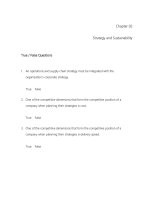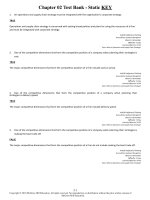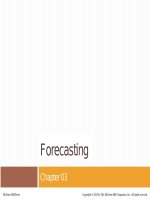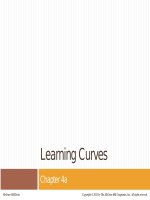Lecture Operations and supply chain management: The Core (3/e) – Chapter 11: Inventory management
Bạn đang xem bản rút gọn của tài liệu. Xem và tải ngay bản đầy đủ của tài liệu tại đây (1007.29 KB, 15 trang )
Inventory Management
Chapter 11
McGrawHill/Irwin
Copyright © 2013 by The McGrawHill Companies, Inc. All rights reserved.
Learning Objectives
1.
2.
3.
4.
5.
6.
Explain the different purposes for keeping
inventory.
Understand that the type of inventory
system logic that is appropriate for an item
depends on the type of demand for that
item.
Calculate the appropriate order size when a
one-time purchase must be made.
Describe what the economic order quantity
is and how to calculate it.
Summarize fixed–order quantity and fixed–
time period models, including ways to
determine safety stock when there is
variability in demand.
Discuss why inventory turn is directly
related to order quantity and safety stock.
112
Inventory
Inventory can be visualized as stacks of money sitting
on forklifts, on shelves, and in trucks and planes while
in transit
For many businesses, inventory is the largest asset
on the balance sheet at any given time
Inventory can be difficult to convert back into cash
It is a good idea to try to get your inventory down as
far as possible
The average cost of inventory in the United States is 30 to 35
percent of its value
113
Inventory Models
114
Purposes of Inventory
115
Inventory Costs
116
Demand Types
117
Inventory Systems Comparison
118
Single Period Inventory Model
119
Multi-Period Models
1110
Multi-Period Models Comparison
Fixe dOrde r Quantity
Inventory remaining must
be continually monitored
Has a smaller average
inventory
Favors more expensive
items
Is more appropriate for
important items
Requires more time to
maintain – but is usually
more automated
Is more expensive to
implement
Fixe dTime Pe rio d
Counting takes place only
at the end of the review
period
Has a larger average
inventory
Favors less expensive
items
Is sufficient for lessimportant items
Requires less time to
maintain
Is less expensive to
implement
1111
Fixed-Order Quantity Models Assumptions
Demand for the product is constant and
uniform throughout the period
Lead time (time from ordering to receipt) is
constant
Price per unit of product is constant
Inventory holding cost is based on average
inventory
Ordering or setup costs are constant
All demands for the product will be satisfied
1112
Establishing Safety Stock
Levels
1113
Inventory Models with Price
Breaks
Price varies with the order size
To find the lowest-cost, calculate the order
quantity for each price and see if the quantity is
feasible
1.
2.
Sort prices from lowest to highest and calculate the
order quantity for each price until a feasible order
quantity is found
If the first feasible order quantity is the lowest price,
this is best, otherwise, calculate the total cost for the
first feasible quantity and calculate total cost at each
price lower than the first feasible order quantity
1114
Inventory Management
1115









